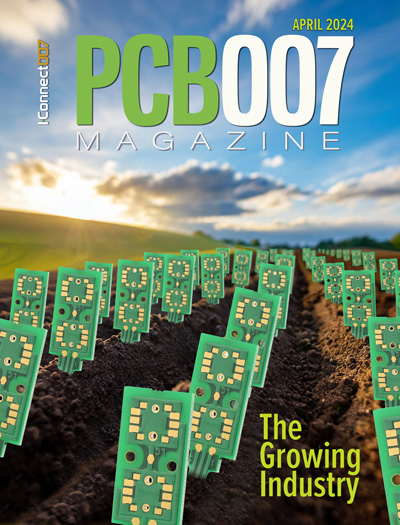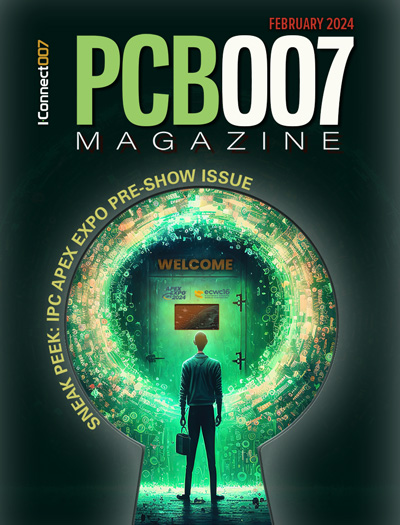-

- News
- Books
Featured Books
- pcb007 Magazine
Latest Issues
Current Issue
The Growing Industry
In this issue of PCB007 Magazine, we talk with leading economic experts, advocacy specialists in Washington, D.C., and PCB company leadership to get a well-rounded picture of what’s happening in the industry today. Don’t miss it.

The Sustainability Issue
Sustainability is one of the most widely used terms in business today, especially for electronics and manufacturing but what does it mean to you? We explore the environmental, business, and economic impacts.

The Fabricator’s Guide to IPC APEX EXPO
This issue previews many of the important events taking place at this year's show and highlights some changes and opportunities. So, buckle up. We are counting down to IPC APEX EXPO 2024.
- Articles
- Columns
Search Console
- Links
- Events
||| MENU - pcb007 Magazine
Improving Copper Distribution in Pattern Plating Using Simulation Software
April 28, 2020 | Pete Starkey, I-Connect007Estimated reading time: 1 minute
DFM guidelines may offer some qualitative rules about aiming for uniformity of copper distribution within a layer and maintaining symmetry in a stackup, but generally, these refer to inner-layer copper and relate to avoiding pressure differentials in the laminating press and bow-and-twist in the reflow oven.
What about the outer layers if the design is to be manufactured by pattern plating, particularly if conductor cross-sections and plated-through-hole finished diameters are critical? Does the PCB designer understand the principles of pattern electroplating? Circuit features in sparsely populated areas will take more than their nominal share of the deposited copper.
And what about panelisation? Is the design required to be delivered as a multiple on an assembly panel? Or is it cost-effective to manufacture only if incorporated into a multi-image production panel—whether of the same design or a mixture of designs?
From the point of view of the PCB fabricator, it is clearly bad practice to interfere with a customer’s design by adding balancing copper as non-functional areas within the layout, unless this is done in consultation with the designer and formally approved before the design is signed-off.
But on a panel, balancing copper—alternatively termed “copper thieving”—may be legitimately added to the panel border and in the spaces in between individual boards in order to improve the uniformity of electroplated copper thickness distribution by effectively stealing some of the plating current that would otherwise tend to be concentrated on sparse features.
From a production standpoint, if the individual boards in a multi-image panel have an uneven copper distribution, or if two or more designs are incorporated in the panel, there could be some benefit in arranging their relative positions and orientations to improve the uniformity of electroplating. Maybe counterintuitively, the yield might be improved by putting fewer images on the panel with more space between them to allow for thieving.
To read this entire article, which appeared in the April 2020 issue of PCB007 Magazine, click here.
Suggested Items
Designer’s Notebook: What Designers Need to Know About Manufacturing, Part 2
04/24/2024 | Vern Solberg -- Column: Designer's NotebookThe printed circuit board (PCB) is the primary base element for providing the interconnect platform for mounting and electrically joining electronic components. When assessing PCB design complexity, first consider the component area and board area ratio. If the surface area for the component interface is restricted, it may justify adopting multilayer or multilayer sequential buildup (SBU) PCB fabrication to enable a more efficient sub-surface circuit interconnect.
Insulectro’s 'Storekeepers' Extend Their Welcome to Technology Village at IPC APEX EXPO
04/03/2024 | InsulectroInsulectro, the largest distributor of materials for use in the manufacture of PCBs and printed electronics, welcomes attendees to its TECHNOLOGY VILLAGE during this year’s IPC APEX EXPO at the Anaheim Convention Center, April 9-11, 2024.
ENNOVI Introduces a New Flexible Circuit Production Process for Low Voltage Connectivity in EV Battery Cell Contacting Systems
04/03/2024 | PRNewswireENNOVI, a mobility electrification solutions partner, introduces a more advanced and sustainable way of producing flexible circuits for low voltage signals in electric vehicle (EV) battery cell contacting systems.
Heavy Copper PCBs: Bridging the Gap Between Design and Fabrication, Part 1
04/01/2024 | Yash Sutariya, Saturn Electronics ServicesThey call me Sparky. This is due to my talent for getting shocked by a variety of voltages and because I cannot seem to keep my hands out of power control cabinets. While I do not have the time to throw the knife switch to the off position, that doesn’t stop me from sticking screwdrivers into the fuse boxes. In all honesty, I’m lucky to be alive. Fortunately, I also have a talent for building high-voltage heavy copper circuit boards. Since this is where I spend most of my time, I can guide you through some potential design for manufacturability (DFM) hazards you may encounter with heavy copper design.
Trouble in Your Tank: Supporting IC Substrates and Advanced Packaging, Part 5
03/19/2024 | Michael Carano -- Column: Trouble in Your TankDirect metallization systems based on conductive graphite or carbon dispersion are quickly gaining acceptance worldwide. Indeed, the environmental and productivity gains one can achieve with these processes are outstanding. In today’s highly competitive and litigious environment, direct metallization reduces costs associated with compliance, waste treatment, and legal issues related to chemical exposure. What makes these processes leaders in the direct metallization space?


